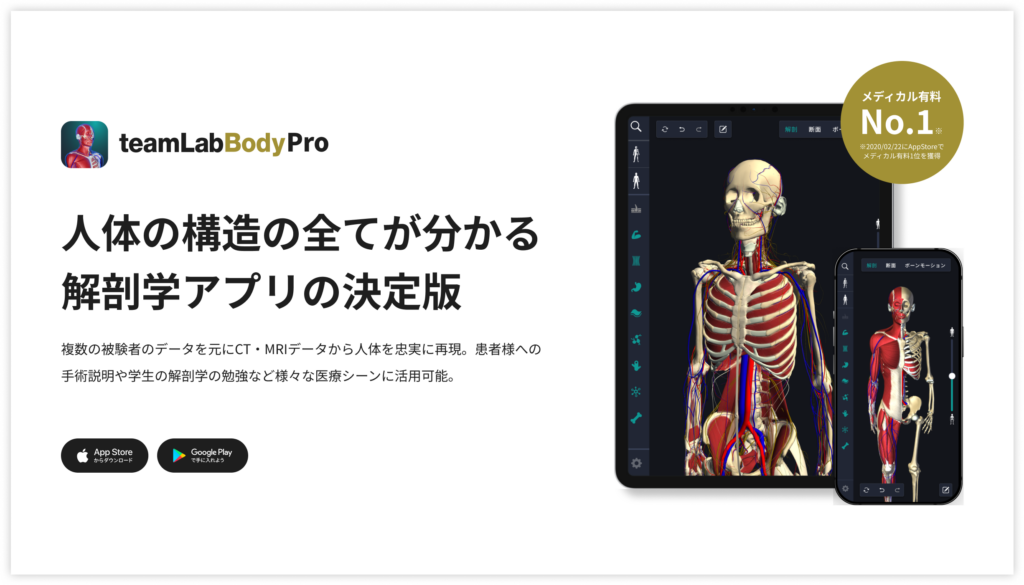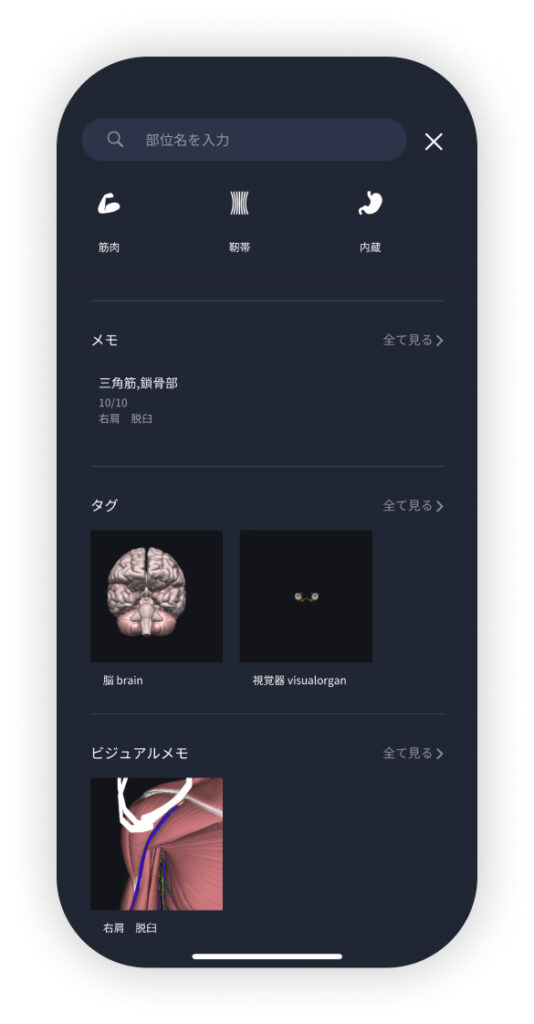beginning
In this article, I will explain effective study methods, starting with knowledge of specialized parts in human anatomy.
In human anatomy, it is necessary not only to memorize the names of various organs, muscles, and bones, but also to remember where they are located in the body. Therefore, it is necessary to learn as efficiently as possible.
I hope you will deepen your understanding even a little by reading this article and using the app.
Now, I'll explain the details about the “apical ligament” and how to study human anatomy.
teamLab Body Pro Free Download
A 3D anatomy app that shows all the structures of the human body
Download teamLab Body Pro here!

What is apical ligament?
The anatomy application allows you to view a selection of anatomy 3D models. In this model, there are various observation methods such as surfaces, cross-sections, and nervous systems. This time, I'll explain using an anatomy application.
About apical ligaments

The apical ligament (apical ligament of dens) is a ligament that connects the tip of the axial vertebra (second cervical vertebra: C2) to the anterior edge of the occipital bone (front edge of the large occipital foramen). It is a small ligament that supports the connection between the skull and the cervical spine, and runs almost vertically in the center. Although it is structurally very thin and inconspicuous, it contributes to maintaining the stability of the annular shaft joint. In particular, by maintaining the movement of the dentition on the central axis, it has the effect of suppressing excessive back and forth bending and rotation of the head, and supports the balance between mobility and stability of the upper cervical vertebrae.
The apical ligament, along with pterygiform ligaments and cruciate ligaments, forms a ligament group called the “craniovertebral junction (craniovertebral junction),” and is also involved in protecting the brain stem and upper spinal cord. Especially in children and the elderly, fragility and looseness of ligaments are likely to be a problem, and falls or trauma may cause instability in the upper cervical spine.
Clinically, it is often paid more attention as part of complex ligament damage rather than damage to the apical ligament alone, and observation is mainly carried out in precise examinations such as MRI.
Therefore, even if they are inconspicuous, understanding the importance of connecting dental processes to the base of the skull and the relationship with surrounding structures three-dimensionally is the key to functional and clinical anatomy learning.
Study points
Anatomical understanding: the role of the small ligament connecting the dentition to the occipital bone
The apical ligament is a thin, short ligament that runs upward from the tip of the dental protrusion of the axial spine to the anterior edge of the large occipital foramen of the occipital bone. Its location is extremely close to the cruciate ligament and pterygium, and is in the deep layers of the neck. Since the structure is difficult to see, it is effective to repeatedly confirm the positional relationship with surrounding ligaments using a 3D anatomy application or tomogram. Also, by collectively grasping “ligament groups surrounding dental processes,” including apical ligaments, relationships between function and structure are organized, and memory retention can also be helped.
Functional understanding: the key to stability that keeps the tooth protrusion in the center
Although the apical ligament has a small structure, it plays a role in suppressing excessive movement of dental protrusions. In particular, it has the function of adding “tension that pulls back to the center” so that the tooth protrusions do not deviate from the axis when the head moves back and forth. In order to understand such dynamic stability, it is effective to actually move the head back and forth, and to use models to imagine the movement of dental processes and the tension of ligaments. Even if you can't see the presence of ligaments, “feeling” their function during movement is the key to deepening understanding.
Practical Applications: Injury Instability and Clinical Assessment
Dental apical ligaments can be a problem during whiplash, high energy trauma, and falls in children and the elderly. Especially in children, ligaments are weaker than bones, so upper cervical spine instability may occur due to damage to the apical ligament. In clinical practice, it is observed as a complex injury with pterygium ligament, transverse ligament, etc. rather than a single injury, so precise evaluation by MRI is important. When learning, if you have the viewpoint of “memorizing the ligament structure around the denticles as a set, not one of them,” your understanding during trauma or illness will be further deepened.
How to study human anatomy
I will explain specific study methods using human anatomy applications.
Check your past learning history and practice repeatedly
Here are the steps to check your anatomy learning history and practice iteratively effectively.
1. Check your learning history in the app
Reviewing your learning history with the application is an important step in effectively advancing anatomy learning. First, launch the app and go to the learning history section from the main menu. Many anatomy apps are designed to show your progress in the form of graphs and lists, so you can visually check which parts you've learned about and how much time you've spent.
By using this data, you can understand which areas you have strengths in and where you need to spend more time and effort. We also recommend using a dedicated tag or notebook function to mark areas you are particularly weak at or where you need to relearn. Regularly checking your learning history and looking back on past learning content will lead to efficient review and deepening understanding.
2.Make a plan for iterative learning
Making an efficient repetitive learning plan based on learning history is extremely effective in promoting knowledge retention. First, identify weak points and areas where you need to relearn. Next, arrange these study items into a weekly or monthly calendar and create a specific study schedule. By proceeding in a planned manner, you can learn each part evenly and avoid packing in a large amount of information at once.
Using a task management app or digital calendar to set study reminders is effective. Also, it's important to have the flexibility to regularly review progress and revise plans as needed. By having goals and proceeding with your studies in a planned manner, you can efficiently acquire anatomical knowledge.
3.Use 3D features to learn visually
By utilizing the 3D function, learning anatomy is easier to understand visually. The 3D model shows the structure of the human body three-dimensionally, and each part can be observed in detail. This makes it possible to intuitively grasp positional relationships between deep muscles and organs that are difficult to capture in a planar view. For example, you can learn even the smallest details by rotating specific muscles and bones and zooming in and out.
Also, there are many apps that have the function of displaying cross-sectional views of each part using a 3D model, which is useful for deepening understanding of internal structures. This diversity of visual information helps with memory retention and improves immediate responsiveness in tests and practice situations. By utilizing the 3D function and learning visually, you can learn anatomy knowledge more deeply and efficiently.
Use the memo function concretely

Make notes so you don't forget the things and points you've noticed while studying. The memo function can be used for different purposes, such as inputting text, saving images, and writing memos. Tag your notes to make them easier to review later.
Test your learning regularly in the form of quizzes
Regularly testing what you've learned in a quiz format is a very effective way to anchor your anatomy knowledge. Quiz-style tests help you objectively grasp your level of understanding and areas you lack while repeating knowledge.
For example, by using a learning app to conduct quizzes every specific period, you can reconfirm what you've learned and strengthen your memory. There are a wide range of quiz formats, such as multiple choice questions, fill-in-the-blank questions, and short answer questions, and each helps understanding from a different angle and develops the ability to utilize various types of knowledge.
Get feedback
If possible, get feedback from other learners and experts. It helps you find your own gaps in understanding and areas for improvement. You can also keep yourself motivated to learn by regularly testing yourself. Feeling a sense of accomplishment and progress increases motivation for continuous learning.
summary
This time, I explained how to study about the “apical ligament” using an application!
Thank you for reading this far.
I would be happy if reading this article helped you learn about anatomy.
Learning is a long, never-ending journey, but I sincerely wish you all the best. Let's continue to study together and work hard for the national exam!
Please look forward to the next blog.
teamLab Body Pro Free Download
A 3D anatomy app that shows all the structures of the human body
Download teamLab Body Pro here!





